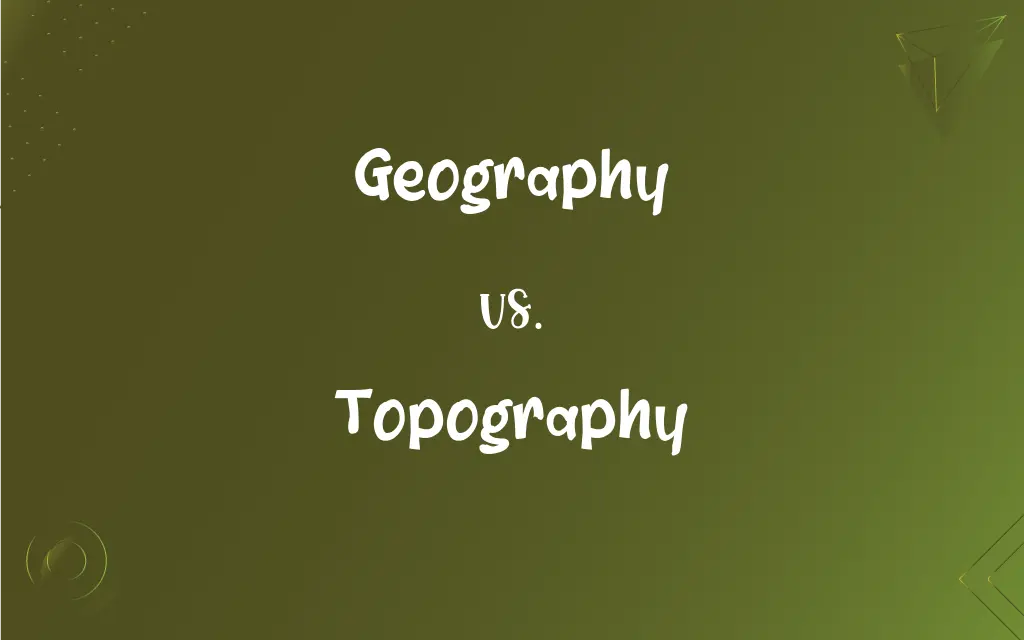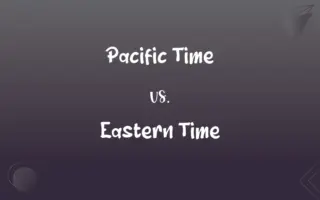Geography vs. Topography: What's the Difference?
Edited by Aimie Carlson || By Janet White || Published on December 2, 2023
Geography is the study of Earth's landscapes, environments, and the relationships between people and their environments. Topography is the detailed mapping or charting of the features of a relatively small area, district, or locality.

Key Differences
Geography encompasses the study of the Earth's surface, including human and natural phenomena, and their interactions. It is broad and includes cultural, political, and economic aspects. Topography, however, specifically refers to the detailed description and representation of physical features of a particular area, focusing on terrain and landforms.
Geographers study patterns and processes related to climate, vegetation, population, and urban development. Their work often includes examining human activities and their impacts on the Earth. Topography is concerned with the shape and features of the Earth's surface, such as mountains, valleys, and rivers, often used for planning and construction.
In geography, spatial relationships and global patterns, such as migration or climate change, are analyzed. It’s a discipline that integrates various subjects to understand the world. Topography is more technical, involving precise measurements and mapping of physical terrain, often essential in architecture, engineering, and military planning.
Geography can be divided into physical geography, studying natural environments, and human geography, focusing on human societies. It's a comprehensive field that looks at the world as a whole. Topography is a component of physical geography but is more specialized, dealing with the detailed surveying and mapping of land features.
Geographical studies often include topographical elements, but they also go beyond them to include human interaction with the environment. Topography, however, remains focused on physical land features, without delving into human societal aspects.
ADVERTISEMENT
Comparison Chart
Focus
Study of Earth's surface, including human and natural phenomena
Detailed description of physical land features
Scope
Broad, encompassing physical, cultural, and human elements
Specific, focusing on terrain and landforms
Application
Analysis of global patterns, human activities, and their environmental impacts
Precise mapping for construction, planning, and environmental understanding
Sub-Disciplines
Physical and human geography
A specialized branch of physical geography
Relation to Humans
Includes human interaction with the environment
Primarily focused on physical features, less on human aspects
ADVERTISEMENT
Geography and Topography Definitions
Geography
The analysis of the relationships between human societies and their environments.
Urban geography explores how cities develop and change over time.
Topography
The arrangement of natural and artificial physical features of an area.
The city's topography was shaped by both its river and urban development.
Geography
The study of Earth's surface, including physical, social, and cultural features.
In geography class, we learned about the diverse cultures of Southeast Asia.
Topography
The study of the shape and features of the Earth’s surface.
Mountainous topography presents unique challenges for builders.
Geography
An academic discipline examining the spatial distribution of features on Earth's surface.
Geography explains why certain regions are more prone to earthquakes.
Topography
The detailed mapping of the surface features of a place or region.
The topography of the area revealed a previously unknown river.
Geography
A field that integrates natural sciences and humanities to study places and relationships.
Her interest in geography led to a career in environmental conservation.
Topography
The representation of surface features on maps, showing their positions and elevations.
Accurate topography is crucial for planning hiking routes in mountainous areas.
Geography
The exploration of spatial connections in both natural and human-made environments.
Geography helps us understand the impacts of climate change globally.
Topography
The description or depiction of the physical features of a region.
The topography of the coastal region includes cliffs and sandy beaches.
Geography
The study of the earth and its features and of the distribution of life on the earth, including human life and the effects of human activity.
Topography
Detailed, precise description of a place or region.
Geography
The physical characteristics, especially the surface features, of an area.
Topography
Graphic representation of the surface features of a place or region on a map, indicating their relative positions and elevations.
FAQs
What is topography mainly about?
Topography is about mapping and describing the physical features of a specific area.
How is geography different from topography?
Geography is a broader field studying various aspects of Earth, while topography focuses specifically on physical land features.
Do geographers use topographical maps?
Yes, geographers often use topographical maps to understand physical terrain and features.
Can geography help in disaster management?
Yes, geography can provide insights into risk areas and aid in disaster management planning.
Can topography influence geographic studies?
Yes, topography can influence geographic studies, particularly in physical geography.
Are topographical maps used in hiking?
Yes, hikers use topographical maps to navigate terrain and understand elevation changes.
What does geography cover?
Geography covers the study of Earth's physical features, human societies, and their interactions.
Is topography limited to natural features?
Topography includes both natural and man-made features of the landscape.
Does topography play a role in urban planning?
Yes, topography is important in urban planning for infrastructure development and land use.
What technology is used in topographical mapping?
Technologies like GIS (Geographic Information Systems) and remote sensing are used in topographical mapping.
How important is geography in understanding climate change?
Geography is crucial for understanding the spatial aspects and impacts of climate change.
What skills do geographers develop?
Geographers develop skills in spatial thinking, data analysis, and understanding human-environment interactions.
Does geography include cultural studies?
Yes, geography includes cultural studies, examining how culture interacts with the environment.
Can topography influence a region's climate?
Yes, topography can influence local climate conditions, like rainfall patterns and temperature.
Is geography a science or humanities discipline?
Geography is both a science and humanities discipline, integrating aspects of both.
How does geography affect economic development?
Geography affects economic development through resource distribution, location advantages, and environmental conditions.
How detailed are topographical surveys?
Topographical surveys are highly detailed, showing elevations and features accurately.
What role does geography play in education?
Geography education helps students understand the world, its environments, and global relationships.
Is learning topography useful for architects?
Yes, architects benefit from understanding topography for building design and site planning.
What are the key elements of topography?
Key elements of topography include landforms, elevation, and the arrangement of physical features.
About Author
Written by
Janet WhiteJanet White has been an esteemed writer and blogger for Difference Wiki. Holding a Master's degree in Science and Medical Journalism from the prestigious Boston University, she has consistently demonstrated her expertise and passion for her field. When she's not immersed in her work, Janet relishes her time exercising, delving into a good book, and cherishing moments with friends and family.
Edited by
Aimie CarlsonAimie Carlson, holding a master's degree in English literature, is a fervent English language enthusiast. She lends her writing talents to Difference Wiki, a prominent website that specializes in comparisons, offering readers insightful analyses that both captivate and inform.






































































